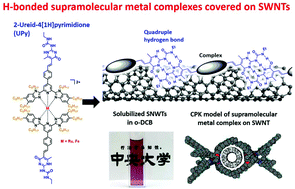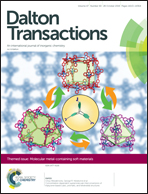Hydrogen-bonded metallo-supramolecular polymers based on ruthenium or iron complexes for the selective extraction of single-walled carbon nanotubes†
Abstract
The chemical functionalization of nano-carbon materials such as single-walled carbon nanotubes (SWNTs) and graphene by metal complexes has attracted much attention due to the multitude of potential applications in efficient energy-conversion and -storage devices. The solubilization and single-chirality separation of SWNTs by surface modifications is a useful approach to manipulate SWNTs in the liquid phase. In this study, several Ru and Fe complexes containing two terminal quadruple hydrogen-bonded (H-bonded) ureidopyrimidinedione (UPy) groups were synthesized (Ru-1, Ru-UPy, and Fe-UPy) to form H-bonded supramolecular polymers by self-association. In order to control the solubility of these complexes in nonpolar solvents, Ru-UPy and Fe-UPy were endowed with long alkyl side chain groups in the coordinated 2,6-bis(benzimidazol-2-yl)pyridine ligand, while Ru-1 and Ru-2 do not contain such long alkyl chain groups. AFM measurements revealed that Ru-1, Ru-UPy, and Fe-UPy form a fiber-like network morphology on HOPG surfaces, arising from the H-bonded aggregation. However, only Ru-UPy and Fe-UPy are able to solubilize SWNTs effectively upon simple sonication in chlorobenzene. After the solubilization of a CoMoCAT® SWNT in chlorobenzene using Ru-UPy or Fe-UPy, UV-Vis-NIR spectra showed sharp peaks at 996 and 1150 nm, which were attributed to (6, 5) and (7, 6)-SWNTs. The Raman spectra of the solubilized SWNTs revealed peaks that were attributed to the radial breathing mode (RBM), which suggests an enrichment of semiconducting SWNTs, i.e., Ru-UPy and Fe-UPy are able to selectively solubilize semiconducting SWNTs. Cyclic voltammograms of films of SWNTs covered with Ru-UPy or Fe-UPy on ITO electrodes showed a well-defined adsorbed Ru(II/III) or Fe(II/III) wave. Upon addition of acid, the redox response from the adsorbed H-bonded Ru-UPy and Fe-UPy disappeared and only SWNTs were left on the ITO electrode. Moreover, the Ru-UPy/SWNT and Fe-UPy/SWNT hybrids exhibited non-linear I–V characteristics.

- This article is part of the themed collection: Molecular metal-containing soft materials


 Please wait while we load your content...
Please wait while we load your content...